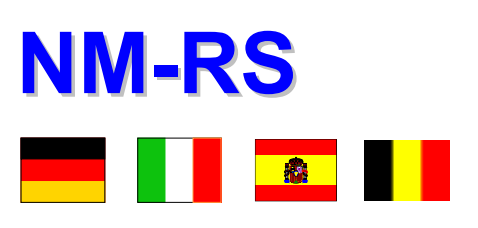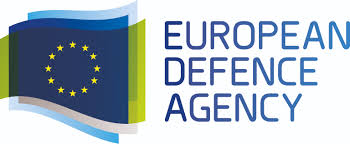
The project Networked Multi-Robot System (NM-RS) was the first Category B project contracted under the supervision and the coordination of the European Defence Agency. The participating member states (pMS) were Germany (as lead nation), Italy, Spain and Belgium.
The NM-RS project started in June 2007 and was successfully terminated in July 2010. In these 36 months the NM-RS project team – consisting of industrial partners from four European Nations – realised within a simulation system a networked multi-robot system to evaluate the performance and the benefits of such a networked system performing autonomously coordinated operations.
The industrial group consisted of:
- Diehl BGT Defence (main contractor) and Fraunhofer FKIE from Germany,
- OTO Melara together with Celin Avio and Scuola Superiore Sant’Anna from Italy
- SENER and Universidad Politécnica de Madrid from Spain
- Patrimony of the Royal Military School (PRMS) from Belgium
The main objective of the project was to
1. Focus on robots to reduce the risk of personal damage or loss of life
2. Increase the efficiency for military operations i.e. reconnaissance, inspection and
security
To reach the objectives within the given time and the financial volume the project NM-RS was realised in a simulation system. The lessons learned in realising NM-RS were thought to gain knowledge in the field of networked robot systems and to improve the initial knowledge for a possible hardware realisation.
The requirement of a realistic performance in a simulation environment determined the simulation of all parts – i.e. the complete environment (including static and moving objects, enemy forces, civilians, etc.), the various robot platforms (including their realistic physics), all sensors (including all gathered sensor data and a learning system) and the communication itself (including a realistic communication model).
The algorithms for the guidance, navigation and control of the robot platforms and the coordination of the multi-robot system (centralised as well as decentralised) are on the other hand real algorithms which are designed to use simulated as well as real sensor data. This allows the transfer of the NM-RS results into the real world and the implementation of the
NM-RS algorithms in existing hardware.
European Defence Agency
Category B project
2007 – 2010

Project Publications
2011
- D. Doroftei and E. Colon, “Decentralized multi-robot coordination for a risky surveillance application," in Proc. IARP HUDEM 2011, Sibenik, Croatia, 2011.
[BibTeX] [Abstract] [Download PDF]
This paper proposes a multi-robot control methodology that is based on a behavior-based control framework. In this behavior-based context, the robotic team members are controlled using one of 2 mutually exclusive behaviors: patrolling or intercepting. In patrol mode the robot seeks to detect enemy forces as rapidly as possible, by balancing 2 constraints: the intervention time should be minimized and the map coverage should be maximized. In interception mode, the robot tries to advance towards an enemy which was detected by one of the robotic team members. Subsequently, the robot tries to neutralize the threat posed by the enemy before enemy is able to reach the camp.
@InProceedings{doro2011decentralized, author = {Doroftei, Daniela and Colon, Eric}, booktitle = {Proc. {IARP} {HUDEM} 2011}, title = {Decentralized multi-robot coordination for a risky surveillance application}, year = {2011}, publisher = {{IARP}}, abstract = {This paper proposes a multi-robot control methodology that is based on a behavior-based control framework. In this behavior-based context, the robotic team members are controlled using one of 2 mutually exclusive behaviors: patrolling or intercepting. In patrol mode the robot seeks to detect enemy forces as rapidly as possible, by balancing 2 constraints: the intervention time should be minimized and the map coverage should be maximized. In interception mode, the robot tries to advance towards an enemy which was detected by one of the robotic team members. Subsequently, the robot tries to neutralize the threat posed by the enemy before enemy is able to reach the camp. }, project = {NMRS}, address = {Sibenik, Croatia}, url = {http://mecatron.rma.ac.be/pub/2011/HUDEM2011_Doroftei_Colon.pdf}, unit= {meca-ras} }
2010
- D. Doroftei and E. Colon, “Decentralized Multi-Robot Coordination in an Urban Environment," European Journal of Mechanical en Environmental Engineering, vol. 1, 2010.
[BibTeX] [Abstract] [Download PDF]
In this paper, a novel control strategy is presented for multi‐robot coordination. An important aspect of the presented control architecture is that it is formulated in a decentralized context. This means that the robots cannot rely on traditional global path planning algorithms for navigation. The presented approach casts the multi‐robot control problem as a behavior‐based control problem.
@Article{doro2010decentralized, author = {Doroftei, Daniela and Colon, Eric}, journal = {European Journal of Mechanical en Environmental Engineering}, title = {Decentralized Multi-Robot Coordination in an Urban Environment}, year = {2010}, volume = {1}, abstract = {In this paper, a novel control strategy is presented for multi‐robot coordination. An important aspect of the presented control architecture is that it is formulated in a decentralized context. This means that the robots cannot rely on traditional global path planning algorithms for navigation. The presented approach casts the multi‐robot control problem as a behavior‐based control problem. }, project = {NMRS}, address = {Sheffield, UK}, url = {http://mecatron.rma.ac.be/pub/2010/EJMEE2010_doroftei_colon.pdf}, unit= {meca-ras} } - D. Doroftei and E. Colon, “Multi-robot collaboration and coordination in a high-risk transportation scenario," in Proc. IARP HUDEM 2010, Sousse, Tunisia, 2010.
[BibTeX] [Abstract] [Download PDF]
This paper discusses a decentralized multi-robot coordination strategy which aims to control and guide a team of robotic agents safely through a hostile area. The ”hostility” of the environment is due to the presence of enemy forces, seeking to intercept the robotic team. In order to avoid detection and ensure global team safety, the robotic agents must carefully plan their trajectory towards a list of goal locations, while holding a defensive formation.
@InProceedings{doro2001multi, author = {Doroftei, Daniela and Colon, Eric}, booktitle = {Proc. {IARP} {HUDEM} 2010}, title = {Multi-robot collaboration and coordination in a high-risk transportation scenario}, year = {2010}, publisher = {{IARP}}, abstract = {This paper discusses a decentralized multi-robot coordination strategy which aims to control and guide a team of robotic agents safely through a hostile area. The ”hostility” of the environment is due to the presence of enemy forces, seeking to intercept the robotic team. In order to avoid detection and ensure global team safety, the robotic agents must carefully plan their trajectory towards a list of goal locations, while holding a defensive formation. }, project = {NMRS}, address = {Sousse, Tunisia}, url = {http://mecatron.rma.ac.be/pub/HUDEM/HUDEM%20-%202010/HUDEM2010_Doroftei.pdf}, unit= {meca-ras} } - D. Doroftei and E. Colon, “Decentralized Multi-Robot Coordination for Risky Interventions," in Fourth International Workshop on Robotics for risky interventions and Environmental Surveillance-Maintenance RISE, Sheffield, UK, 2010.
[BibTeX] [Abstract] [Download PDF]
The paper describes an approach to design a behavior-based architecture, how each behavior was designed and how the behavior fusion problem was solved.
@InProceedings{doro2010multibis, author = {Doroftei, Daniela and Colon, Eric}, booktitle = {Fourth International Workshop on Robotics for risky interventions and Environmental Surveillance-Maintenance {RISE}}, title = {Decentralized Multi-Robot Coordination for Risky Interventions}, year = {2010}, abstract = {The paper describes an approach to design a behavior-based architecture, how each behavior was designed and how the behavior fusion problem was solved.}, project = {NMRS, ViewFinder}, address = {Sheffield, UK}, url = {http://mecatron.rma.ac.be/pub/RISE/RISE%20-%202010/Decentralized%20Multi-Robot%20Coordination%20for%20Risky%20Interventio.pdf}, unit= {meca-ras} }
